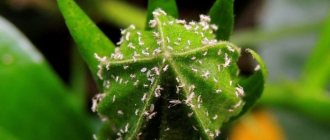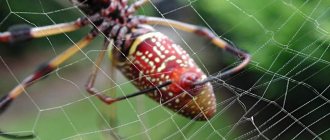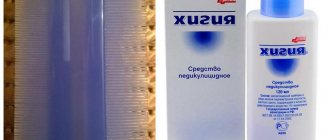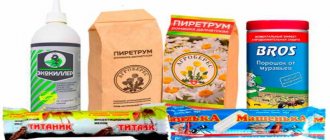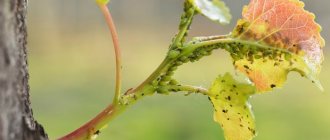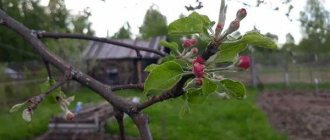Brief characteristics of spider mites
This is the name of a large family of arthropods. It includes a large number of varieties of ticks. Parasites share common external characteristics:
- microscopic dimensions (body length no more than 0.5 mm);
- 8 limbs;
- the color of the cuticle may vary depending on the species, but mainly on eggplants there are individuals of light green, red, and brown colors;
- there are long thin hairs (growing along the surface of the body);
- antennae missing;
- the oral apparatus is of the piercing-sucking type, which means it is less powerful and not as large as that of predatory and blood-sucking individuals.
Spider mites usually live up to 4 weeks
Description and life cycle of the pest
The spider mite is a representative of arachnids with a convex upper body and four pairs of legs. It is difficult to see with the naked eye what the pest looks like, since its average size is 0.5 mm.
Ticks gather in colonies, each of which contains hundreds of individuals. The color of pests changes under the influence of external factors. They are typically grey-green in early summer and orange-red from late summer to early spring. In adults, there are two red eyespots near the head, and numerous bristles cover the body.
The life cycle of a spider mite consists of several stages: egg, larva, nymph and adult. Completing the entire cycle takes from 8-20 or more days.
The most rapid development of ticks occurs at high temperatures (more than +28°C). Another favorable factor for accelerated reproduction of the pest is low humidity (no more than 55%). Adults move from plant to plant using webs.
The fertilized female spider mite spends the winter on plant debris and under the peeling bark of trees. In the spring, when the temperature rises to 12°C, it moves to the surface and settles on the underside of leaves (the first generation reproduces on weeds, the second and subsequent ones move to cultivated plants).
Having weaved a thick web, female mites lay greenish-transparent eggs, placing them one at a time in the web, which then become pearl-colored. The duration of this stage of development is directly related to air temperature.
The development of the larval stage occurs in the interval of 8-20 days. The body is hemispherical, length does not exceed 0.14 mm, three pairs of legs.
The nymph is almost similar to the adult, but smaller in size; at this stage there are already four pairs of legs.
The pest at all stages of development, with the exception of wintering females, causes harm to the plant. By piercing the epidermis from the underside of the leaf, it sucks out the leaf juice with chlorophyll grains from eggplants, which gradually lose their vitality.
Causes and signs of ticks
The spread of pests occurs by planting plants in contaminated soil, through dirty equipment. Purchased seedlings may already be infected. In addition, the possibility of spread by wind must be taken into account. Indirect factors influencing the reproduction and increase in the number of pests:
- soil disinfection is not carried out;
- close location of bushes;
- joint cultivation of eggplants with crops that attract spider mites (for example, tomatoes);
- suitable conditions for reproduction: high temperature and low humidity.
You can determine that there are spider mites on eggplants by a number of signs:
- violation of leaf pigmentation, which is manifested by the appearance of light spots, large areas of a different color (yellow, brown);
- leaf curling;
- slowdown or cessation of plant growth;
- leaf falling;
- the appearance of thin threads of cobwebs;
- detection of small moving points (ticks).
It is clearly visible that the eggplant leaves have disturbed pigmentation
What preventive measures will help in open ground?
When growing crops in open ground, only preventive spraying with specialized and folk remedies against spider mites on eggplants is possible, as well as observing crop rotation. True, the latter does not really help if the pest has already been noticed on the site.
When growing eggplants in greenhouses and in open ground, it is worth providing the plant with frequent (every 3-4 days), abundant watering, otherwise the pest will not keep itself waiting long. It is important to note that the frequency of watering depends on the type of soil; for example, sandy soil is watered more often than loamy soil.
Eggplants grown in open ground can be sprayed with plain water on the driest days to increase air humidity. However, do not forget that spraying is carried out only in the evening or early morning, and during the day it threatens the leaves with sunburn.
After the final harvest, it is necessary to treat the area with bleach. Take 150 grams of the substance per 10 liters of water, dissolve it and simply water or spray the ground. A similar procedure can be carried out in greenhouses, but carefully and only in a protective suit.
How to identify a spider mite?
Spider mites are very small. It can only be seen well under a microscope, especially considering its green color. It initially lives on the back side of the leaves where it weaves its web (hence the name).
The first signs of infection are faded or discolored dots on the surface of eggplant leaves
The first signs of infection are faded or discolored dots on the surface of eggplant leaves. After some time, these spots acquire a marble tint, and a cobweb can be clearly distinguished under the leaf. After the web has grown well, the plant has only 2-3 weeks left for treatment. If this is not done, the sprout will die.
Symptoms of the lesion
The spider mite settles on the plant in such a way that it is difficult to notice: it first attacks the back side of the leaves, the stem and branches are damaged later. Despite its small size, the tick can cause enormous harm. The tick's green color also makes it difficult to detect it.
Having settled on the back side of the leaves, the pest begins to weave a web. At the initial stage of the infection, you may notice whitish or colorless dots on the surface of the eggplant leaves. After some time, they acquire a marble tint; at this time the web under the leaf is already visible to the naked eye. After a strong growth of the web, no more than 2-3 weeks remain for treatment, then the eggplants will die.
The choice of control method depends on the degree of damage and the stage of development of eggplants.
Signs of defeat
You can save eggplants if you pay attention to their condition in time: external signs of infection with an infectious disease appear, and even before the fruits appear, the condition of the leaves deteriorates.
Moreover, the symptoms of ticks
differ on young and mature plants.
Signs of seedling damage
Eggplants at the initial stage of development are more susceptible to infection, since they have weaker immunity than adult plants. As a result, the seedlings stop developing. Signs of a lack of nutrients appear due to the fact that mites suck out the juice. The leaves wither and fall off. These are the main signs of damage to young plants; usually such changes become visible soon after eggplant infection. Measures are immediately taken to treat the bushes, so the web does not have time to form.
If eggplant seedlings are infected with spider mites, you need to take immediate action.
Signs of damage to adult fetuses
When eggplants grow, slightly different signs appear when they are affected by mites:
- light dots on top of leaves;
- pigmentation – brown spots appear when there are too many punctures;
- marble pattern on the leaves - this effect is ensured as the number of the colony increases;
- leaves are deformed;
- with severe infection, the bush begins to dry out, first the condition of the top worsens;
- the number of ovaries decreases, and those that appear are deformed and small in size;
- When mites appear on eggplants in a greenhouse, a cobweb is always found on the plants, but it can be seen in case of severe infestation; at the initial stage, the cobweb is not visible.
What other pest control methods exist for eggplants?
You can also use a less popular and rather extraordinary method - get predatory mites
In addition to the means listed above, which can be used to destroy spider mites that attack eggplants, you can also use a less popular and rather unusual method - introducing predatory mites.
Don’t be scared right away - it’s completely safe for people and animals, we’re not talking about those ticks that can harm pets or humans, but about those that eat herbivorous ticks, like spider mites. They are called Amblyseius and Phytoseiulus.
These predatory insects are sold in garden shops and sometimes in flower shops, packaged in paper sachets. All you need to do is buy them and release them on the plot or in a greenhouse. The peculiarity of these insects is that each of them can eat 4-6 adult spider mites and about 10 more eggs laid by them per day. Once there is no food left for them in the area (namely spider mites), they will simply die due to lack of food.
Yes, the method is unusual, but it is extremely effective, so you should not immediately dismiss it. Amblyseius and phytoseiulus can cope with even large colonies of spider mites on eggplants, but it is important to purchase them in the quantity needed so that the extermination does not drag on for months.
How to treat eggplants against spider mites
You can get rid of spider mites on eggplants using pesticides, biological and folk remedies. Each method has its pros and cons.
Chemical remedies for spider mites on eggplants
Eggplants, like other crops, are treated against spider mites with acaricide solutions. This is a group of chemicals that destroy specifically herbivorous mites.
Comment! The word "acaricide" comes from the Greek words "acari" - "mite" and "caedo" - "to kill".
The table below describes the most popular and effective preparations, appreciated by gardeners.
| Name | Active substance | Peculiarities |
| "Aktellik" | Pirimiphos-methyl | Universal organophosphorus insectoacaricide for contact and intestinal action. When a spider mite enters the body, it disrupts the functioning of its vital organs. If used systematically, it can cause addiction in the pest. |
| "Envidor" | Spirodiclofen | New generation contact insectoacaricide. The drug does not cause cross-resistance, is effective for populations resistant to other acaricides, and kills ticks at any stage of development. Has high adhesion |
| "Sunmite" | Pyridabene | A highly effective Japanese drug that acts at all stages of spider mite development. The cessation of all types of pest activity can be observed within 15 minutes. Ticks fall into a coma and can no longer harm eggplant plantings |
| "Neoron" | Bromopropylate (isopropyl-4,4′-dibromobenzilate) | Contact acaricide, effective at all mobile stages of spider mite development. Does not lose properties at low and high temperatures. Safe for bees and other beneficial insects |
| "Karbofos" | Malathion | Organophosphorus preparation of contact action. It affects the tick only when it comes into contact with the body of an arthropod. With regular use, spider mites develop immunity. |
Warning! When working with pesticides, it is imperative to use personal protective equipment.
Biological remedies for spider mites on eggplants
Biological products for combating spider mites on eggplants have the same effectiveness as pesticides, however, they are less aggressive to the environment and are not dangerous to humans and animals.
The basis of many bioacaricides are beneficial living microorganisms:
- bacteria;
- mushrooms;
- viruses.
Another component of the bioacaricide is plant extracts, which act as a fertilizer and fungicide. Using biological products on eggplants, you can immediately solve three problems:
- get rid of the hated spider mite;
- feed the plants;
- carry out prevention of fungal diseases.
| Name | Active ingredient or live culture | Peculiarities |
| "Fitoverm" | Aversectin C | A powerful product that shows results within five hours after spraying. Protection lasts for 20 days. Three days after the last treatment, eggplants are edible. Thanks to the presence of an adjuvant in protected soil, consumption can be significantly reduced |
| "Vermitek" | Abamectin | Bioinsectoacaricide of contact-intestinal action. Does not have phytotoxicity. Has a long protection period - up to one month |
| "Akarin" | Avertin N | Biological product with enteric contact action. It has a high rate of impact on pests. Already 8-16 hours after treatment, the tick stops feeding and loses motor activity |
| "Apollo" | Clofentesine | It has an ovicidal effect and is effective at all stages. Toxic effects continue for 30 days. Not dangerous for predatory mites and beneficial insects |
| "Bitoxibacillin" | Spores of Bacillus thuringiensis var. thuringiensis | Not a phytotoxic biological preparation. Can be used at any stage of plant development. The fruits are allowed to be eaten five days after processing |
An unusual biological method for controlling spider mites is the breeding of predatory mites (Phytoseiulus persimilis, Amblyseius californicus). They are sold in many garden centers. The gardener can only release them onto the eggplant foliage. During the day, one hunter mite destroys 4-6 adult spider mites and about 10 eggs. When there is no suitable food left, the acariphages die.
Folk remedies for spider mites on eggplants
The use of folk remedies is advisable if chemicals and biological products cannot be used or are not at hand. Such methods are effective for minor tick infestations, as well as for complex pest control. Their action is slow and more gentle; they are not dangerous for humans and pets.
Garlic
Crushed garlic cloves (3-4 pieces) are infused in 1 liter of water for two days. Before processing, the infusion is diluted with water 1:1. In calm, dry weather, spray the tops and soil surface.
alder leaves
Dry or fresh alder leaves (200 g) are steamed with boiling water (2 l) and simmered over low heat for half an hour. Then the broth is cooled and allowed to brew for 12 hours, after which it is filtered and sprinkled on the eggplants.
Mustard
To obtain a mustard infusion against spider mites, 60 g of powder is diluted in 1 liter of water. In three days it will be ready for use.
Onion peel
100 g of onion peel is poured into 5 liters of water, covered with gauze and left in a cool place for five days. Eggplant plantings are sprayed after watering, after shaking the onion infusion.
Advice! For better adhesion to the leaves, you can add a little laundry soap to the infusion.
alder leaves
Dry or fresh alder leaves (200 g) are steamed with boiling water (2 l) and simmered over low heat for half an hour. Then the broth is cooled and allowed to brew for 12 hours, after which it is filtered and sprinkled on the eggplants.
Dandelion
One of the fastest ways to prepare an infusion against mites on eggplants is to use ordinary dandelion. The leaves and rhizomes are crushed, poured with boiling water and left for three hours. For 1 liter of water you need 100 g of grass. The strained, cooled infusion is sprayed onto eggplant bushes without diluting it with water.
Tobacco dust and ash
Tobacco dust is mixed with wood ash in equal parts. The dry mixture is sprinkled on the bushes twice a summer. 100 g of powder is consumed per 1 m².
Green soap
Green soap contains potassium salt, fatty acids and vegetable oils. 400 ml of the drug is diluted per 10 liters of water. To wash the leaves, you also use laundry soap diluted in water (20 g per 1 liter). Many gardeners advise spraying eggplant plantings with a solution of sulfur-tar soap (100 g per 10 l).
Ammonia
To prepare the solution 1 tbsp. l. ammonia is stirred in 10 liters of water. The plants are sprayed, trying to get it not only on the top, but also on the back side of the leaves.
Important! All treatments, regardless of the method of control, must be carried out after mechanically washing off the cobwebs and mites using a cotton swab, and completely drying the surface of the leaves.
Biological products. Bioacaricides
Such products contain pathogenic microorganisms (fungi, viruses, bacteria). The principle of action is based on the ability of drugs in this group to have a negative effect on parasites. Such methods are more effective than folk remedies for spider mites on eggplants. The biological product is not phytotoxic, so treatment is often carried out without reference to the flowering period or the formation of ovaries. But it is important to wait several days between the harvesting procedure and spraying the biological product.
Besides,
Such products often contain components that help feed plants.
Examples of biological products:
- Fitoverm (contains aversectin C);
- Vertimek (main component – abamectin);
- Akarin (contains the acaricidal substance Avertin N).
The drug “Akarin” (“Agravertin”)
Akarin
"Akarin" is made from a fungus that lives in the soil. It is used in the form of a solution, which is prepared on the basis of 8 ml of “Akarin” and 1 liter of water. For sheet processing, choose a period when the air temperature is from 12 to 25°C.
The first results from using the drug are visible after 2 days. Within a week, the final death of the pests occurs.
Aktofit
Has a paralytic effect on spider mites. "Actofit" is used only in the absence of rain and temperatures above +18°C. The solution is prepared based on a certain ratio: 4 ml of the drug per 1 liter of water. The active ingredient is also aversectin C.
The number of treatments per season is no more than two. During eggplant flowering, “Aktofit” is not used because it is harmful to bees. The last use of the drug should take place two days before harvesting vegetables. When interacting with moisture and soil, “Aktofit” quickly collapses.
Insectoacaricides of chemical origin
These are the most effective means available. They can cause harm to plants and fruits, so it is important to adhere to the dosage and application regimen recommended by the manufacturer. Chemicals are used long before flowering and harvesting. To spray plants, you should prepare: put on latex gloves, closed clothing, a respirator, and a hat.
To save eggplants
against spider mites, 2-3 treatments will be required (in spring and autumn).
How and with what to treat eggplants to exterminate spider mites
In greenhouses and greenhouses, as well as in garden beds, spraying and dry processing will help eggplants.
Important! If the spider pests have developed tolerance to the drug, then the product needs to be changed until the problem is eradicated.
Traditional methods against spider web pests
It has been noted that the spider insect, which threatens eggplants with loss of harvest, is afraid of some plants.
Important! Mulching around grown eggplants with picked fresh herbs from the list will have a similar negative effect on ticks.
Biological products for exterminating spider mites on eggplant
The development of biological products was based on the principle of environmental purity, so that the effect was directed exclusively to the pest that tasted the greens after treatment with them.
Important! When working with a solution of a biological product, protective measures will be required, as indicated in the instructions, since they are somewhat toxic to humans when inhaling vapors.
Insectoacaricides of chemical origin
A formidable weapon that leaves no chance of survival against spider webs and other pests at any stage of transformation is still being improved. After all, the pest also fights for its own survival by developing immunity to traditional pesticides in new generations.
Important! If vapors from the active solution enter the respiratory system, this can lead to poisoning, so personal protective equipment when spraying is strictly required!
Chemicals
The most effective method of dealing with spider mites on eggplants is the use of chemicals. This includes drugs whose action is aimed at destroying the pest. Before use, you should read the instructions.
Fitoverm
The drug Fitoverm operates on the basis of aversectin, which paralyzes pests. The product does not affect tick eggs, so re-treatment is necessary.
Fitoverm is not used with other drugs against ticks. The action of the main substance begins a few hours after treatment, when the nervous system of the pests is paralyzed.
Important! The death of insects from Fitoverm occurs on the third day. Stronger representatives die after 6 days.
After treatment against spider mites on eggplants in a greenhouse, the drug retains its properties for 20 days. In open ground, with intense precipitation, dew and high air humidity, this period is reduced to 6 days.
To get rid of the pest, prepare a solution containing 1 ml of Fitoverm per liter of water. Spraying is carried out every 20 days. This amount is enough to process 10 square meters. m landings.
Bitoxibacillin
The drug Bitoxibacillin is sold in powder form and allows you to effectively combat garden pests. The product is effective against larvae and adults.
After using Bitoxibacillin, the death of the pest occurs within 3-5 days. After a week, repeated treatment is carried out to eliminate the colony of new mites.
Advice! The drug should not come into contact with the skin and other organs. Therefore, the use of protective equipment is mandatory.
100 g of the product are diluted in a bucket of water, after which the eggplants are sprayed. Bitoxibacillin is used before and during flowering, the appearance of ovaries and fruits. It is not allowed to carry out treatment a week before harvest.
Aktellik
Another option for treating eggplants against spider mites is Actellik. The drug acts on pests through the intestinal contact method. Depending on weather conditions and the period of development, ticks die within a few minutes or hours.
After treatment, the effect of Actellik lasts for 2 weeks. Treatment is carried out in the absence of rain and wind, at an ambient temperature of +12 to +25°C.
Important! For spraying eggplants, the Actellik concentration is 1 ml per liter of water.
The consumption of the drug is determined from the norm of 1 liter of solution for every 10 square meters. m. When used in open ground, the specified norm is doubled.
Neoron
Neoron is a drug whose action is directed against various types of ticks. The product copes with the pest at all stages of its development, from the larva to the adult. The drug partially affects tick laying.
Important! Based on Neoron, a solution is prepared consisting of 1 ml of the substance and 1 liter of water.
Eggplants have always been treated with chemicals leaf by leaf. Neoron can be used with non-alkaline drugs. Its effect lasts for 10-40 days depending on external conditions. Insect death occurs within several hours after contact with treated plants.
Nissan
The action of this drug is aimed at tick eggs and larvae. The result of its use is noticeable on the 10th day. To process eggplants, prepare a 1% solution.
Sunmite
The drug is available in the form of a white or light brown powder. Sunmite acts on various types of mites, including spider mites.
The active ingredient of the drug is pyridabene, which causes paralysis of insects. It is recommended to use the drug on a cloudy day, since its active ingredient is destroyed in direct sunlight.
Important! After treatment, Sunmite remains effective for 3 weeks.
The product acts on ticks regardless of the stage of development and does not cause addiction in insects. The effect of using Sunmite is observed within 15 minutes after treatment.
To solve the question of how to get rid of spider mites, a working solution is prepared. It is obtained by dissolving 1 g of the substance in 1 liter of water. Processing is carried out using the sheet method.
Floromite
The product is directed against larvae and adult ticks. It takes 3 days to completely destroy the pest. After treatment, the effect of its use lasts for 3 weeks.
To prepare the solution you will need 4 ml of Floromite per 10 liters of water. No more than 2 treatments are carried out per season.
Colloidal sulfur
Using colloidal sulfur you can stop the spread of spider mites. The substance is not used during the flowering period of eggplants. The last treatment is carried out at least three days before harvest.
Important! The protective properties of sulfur last for 10 days. The first results can be observed after 3 days.
To combat spider mites on eggplants, prepare a solution containing 40 g of the substance and 5 liters of water. First, colloidal sulfur is diluted with a small amount of water, thoroughly ground and mixed.
Add 0.5 liters of water to the resulting mass and mix until a solution of homogeneous consistency is obtained. Then add the remaining 4.5 liters of water. Gloves are used when working with colloidal sulfur.
Basic methods of pest extermination
The fight against spider mites begins at the first signs of damage to a vegetable crop. The pest can not only spoil the leaves, but also become a carrier of various diseases:
- gray rot;
- viral necrosis;
- mosaic of nightshades.
Attention. The mite can also infect neighboring plants.
Folk remedies
In order not to spray vegetables with chemicals, including many toxic ones, you can turn to natural formulations. A concentrated solution of laundry soap can deal with cobwebs on eggplants.
The preparation is simple:
- Grate a bar of laundry soap.
- Dilute in 10 liters of warm water.
- Stir the mixture periodically for 2 hours until the soap is completely dissolved.
The composition can be applied at any time during the growing season; it is safe for plants. It is advisable to wash each leaf well with soapy foam. You can add ethyl alcohol to the solution at the rate of 20 ml per 1 liter of composition.
Dry tobacco leaves are used to make a decoction. Proportion – 45 g per 1 liter of water. Before applying to plants, the product is half diluted with water.
Garlic is known for various beneficial properties and can provide significant support in pest control. Finely chop a large head of garlic and add 0.5 liters of water. The product is infused for 10-2 hours, diluted 1:2 before spraying.
Dandelions grow in every area, their leaves and roots will become the basis of a good remedy against dangerous pests. You will need to pick 300 g of leaves or dig up 200 g of plant roots. After crushing the dandelion, add 10 liters of water. After 3 hours, the product is ready for use in the garden.
By collecting dandelions, garlic and soap solution together, you get a complex action product. It is used once a week in the evening.
Attention. After processing the eggplant, do not forget to pull out all the weeds and remove them from the area. Pests can move onto the grass, and after a while repeat the attack on vegetables.
What can you do to prevent spider webs from spreading on your eggplants? It is necessary to pick off and burn leaves infected with the pest. It will not be possible to save them, because it is unrealistic to remove all microscopic mites. It is necessary to promptly remove tops, weeds, and fallen leaves from the garden. If infestation occurs, it is recommended to replace the top layer of soil. Treating the soil with a 2% bleach solution is effective.
Narrowly targeted chemicals
The use of folk remedies does not always allow you to completely get rid of spider mites. In case of significant damage to plants, it is worth resorting to acaricides. Ticks belong to the arachnid family, so insecticidal preparations cannot exterminate them.
Attention. Acaricides that affect ticks are divided into two groups: insectroacaricides and specific acaricides. The first group is effective on adults, but does not penetrate eggs well.
Among the recommended drugs:
Acaricide "Neoron" effectively fights various types of ticks. The drug does not penetrate into leaves and fruits and has low toxicity. Has a long-lasting protective effect up to 4 weeks. When exposed to it, mobile adults and larvae die. The composition is safe for beneficial insects. It is used without fear during the flowering period of vegetable and fruit crops. Spray the plants with a fresh solution, thoroughly moistening the leaves.
Contact preparation "Apollo" allows you to destroy pests on eggplants and other crops. The advantage of the composition is that it has an effective effect on tick eggs and larvae. It has a specific effect on adults - it deprives them of the opportunity to reproduce. The population is sharply reduced to a minimum. The drug is sold in concentrated form, in bottles of 0.5 and 1 liter. "Apollo" has a long action. When spraying, it is necessary to thoroughly wet the surface of the leaves on both sides.
The unique preparation “Fitoferm” is widely used in open ground and in greenhouses. Its feature is low toxicity; the composition can be used several days before harvest. The diluted preparation is sprayed up to 4 times per season, the recommended interval is 10-20 days.
“Fitoferm” instantly paralyzes a tick after being eaten; its high poisoning ability allows you to quickly rid your garden of pests. It is better to use the evening time to spray the drug, giving preference to windless days.
The biological preparation "Akarin" helps to quickly get rid of mites, aphids and ants. The concentrated composition is diluted 4 ml per 2 liters of water. It is recommended to spray vegetables in the morning or evening, when it is not hot outside. Eggplant leaves are processed on both sides. The result appears within 2 days, and it will take a week until the pests are completely exterminated.
Spider mites quickly adapt to the action of acaricides, so it is recommended to treat plants with various agents alternately.
Information. If the vegetable crop is processed according to the instructions written on the preparation, then chemicals do not accumulate in the plant. The harvest will remain environmentally friendly.
Agrotechnical measures to combat spider mites on eggplants
Spider mites are active and multiply rapidly under certain environmental conditions. The most favorable conditions for it are low humidity (less than 55%) and high temperature.
An important agrotechnical measure in the fight against spider mites is digging up the soil near the bushes to a depth of 5-8 cm. Row spacing is plowed to a depth of 10-15 cm.
To maintain the required soil moisture, you need to adjust the watering regime for eggplants. Young plants are watered 1 liter per bush twice a week, adults - once a week, spending 2-3 liters. When the eggplants are at the stage of ovary maturation and are actively bearing fruit, watering is carried out 2-3 times a week.
After the moisture has been well absorbed, the soil is loosened, removing weeds. Mulch from compost or grass is poured under the bushes; the layer height should be at least 8 cm. Gradually overheating, it will create a moist and warm environment in which ticks will be uncomfortable.
Where do spider mites come from on eggplants?
Also check out these articles
- Advantages of modern kitchen countertops made of artificial quartz stone
- Red currant - cultivation and care
- How to plant a rose correctly
- Why are lands disappearing?
The main reason for the appearance and active spread of spider mites on eggplants is non-compliance with temperature and humidity conditions. The tick appears at high temperatures (more than +35 degrees) and low humidity (up to 55%). The problem is that while these factors can be controlled in a greenhouse, they cannot be controlled in open ground.
The only thing that a gardener can control when growing crops in the open air is adjusting watering and constructing artificial shade. But with prolonged drought and too high temperatures, all that can be done is to come to terms with it and direct all efforts not to preventing the appearance of the pest, but to fighting it.
You can also treat eggplants with a decoction of onion peels.
To prepare the decoction, take a liter jar, fill it to the brim with onion peels, pour the resulting amount into the pan and add water at the rate of one liter, put it on the fire, as soon as it boils, boil for five minutes, remove and let cool, then strain the decoction, pour it into a bucket and add water at the rate of 10 liters, spray the plants with this solution.
There are several ways to combat spider mites on eggplants, but we should not forget about effective preventive measures.
Mistakes of novice gardeners
Mistakes gardeners make when fighting spider mites:
- Dry air is the main condition for the appearance of mites, so plants in the greenhouse should be sprayed with warm water, especially if it is stuffy outside. Greenhouses must be ventilated.
- When fighting a pest, preventive measures are required. The area where the tick has parasitized is treated with Fitoverm. Eggs and larvae remain in the ground, which do not die at low temperatures, so in the spring of next year the mite will again parasitize nightshade crops.
- To combat the pest, do not forget about regular weeding and removing the remains of dead crops.
- Start fighting the pest with traditional methods that are safe for humans. If they are not effective, proceed to the use of chemicals.
- Only acaricides and insectoacaricides will be effective for controlling ticks. It is useless to use insecticides; they are suitable for insect pests, but spider mites do not belong to this group of pests.
Rate the quality of the article. We want to be better for you:
Causes of mites on grapes
The main factors contributing to the spread of pests:
- move with the wind;
- are in the ground, they are transferred during transplantation;
- distributed along with inventory;
- on clothes and shoes of people and animals.
Warm-blooded animals often harbor parasite eggs. Considering that embryos remain viable for up to 5 years, they can pose a danger under any conditions. But even if the parasite gets on a plant, in an unsuitable environment its numbers will increase slowly or it will completely change its habitat. Indirect factors contributing to the proliferation of parasites:
- violation of feeding rules: inappropriate fertilizers and their dosage are used;
- changes in humidity and temperature levels;
- close location of bushes.
Complex degree of grape infection
Preventive measures in greenhouses
If spider mites have already appeared on eggplants in a greenhouse or on a plot (in open ground), it is necessary to take preventive measures annually to protect the crop from it. Thanks to a number of preventive measures, it is possible to prevent spider mites from infesting eggplants, or at least to keep their colony from spreading and multiplying profusely.
Plants growing in greenhouses and open ground are attacked by spider mites equally. The only significant difference is that raising them in a greenhouse is much easier, since it is an enclosed space.
In order to prevent spider mites from appearing on eggplants in a greenhouse, it is necessary to regulate humidity and temperature. Even in film structures where there is no automatic microclimate adjustment, it is possible to prevent the temperature from rising with basic ventilation - the vents are left open.
In the fall, in order to destroy possible “inhabitants” of the greenhouse, you need to use a simple smoke bomb. All windows in the greenhouse and the door should be closed and a smoke bomb fired inside. It will destroy any pests in the building, including spider mites.
In the fall, to destroy possible “inhabitants” of the greenhouse, you need to use a simple smoke bomb
You can also use a blowtorch. They go over the entire structure of the greenhouse, but carefully so as not to spoil or burn anything! Even those ticks and the eggs they laid that survived in the narrow cracks from the “smoke screen” will not be saved by the blowtorch.
The last preventive measure is changing the soil. This is quite possible to do in a greenhouse. The top layer, in which the pest usually lives and lays eggs, is completely removed, and fresh, new and clean is poured in its place.
Preventing the appearance of mites in the greenhouse
To prevent the appearance of a pest in a greenhouse, experienced gardeners give several recommendations:
- Avoid overheating the air and ventilate the greenhouse regularly.
- Mulching and loosening the soil.
- Maintain humidity conditions. The mite does not like water, so frequent watering (2-3 times a week) will have a beneficial effect on the plants and repel the pest.
- In the fall, fumigate with a smoke bomb. Go through all the cracks of the structure with a blowtorch so that no eggs remain for the winter.
It is worth starting to destroy pests with safe traditional methods, moving on to chemicals if there is no result. Using comprehensive measures to combat and prevent spider mite infestation of eggplants, you will get an excellent harvest in the greenhouse and in the garden.
Advice from experienced summer residents
Gardeners with extensive experience recommend keeping the garden clean and tidy and being attentive to your plantings. In a clean and well-kept garden, plants rarely get sick and have strong immunity.
Some tips to help deal with ticks:
- It is better to pluck damaged parts of seedlings without sparing them.
- Don't rush into using strong chemicals. It is better to resort to their help only in case of severe damage.
- It is useful to spray the seedlings with a solution of ammonia (2 tsp per 1 liter of water).
- Cobwebs must be removed immediately.
- Increase the humidity greatly (at 90-95% the eggs die).
Fighting methods
It is necessary to get rid of spider mites in open ground and in greenhouses in various ways. In the first case, you can safely use insecticides in a greenhouse - these drugs are a last resort measure used if the others have failed.
Treatment measures in the greenhouse
This pest is especially dangerous in closed greenhouses, since due to the combination of an environment comfortable for development and confined space, it spreads extremely quickly and causes colossal damage.
Methods and recommendations for pest control:
- It is necessary to begin treatment when the first signs appear. This will avoid the use of pesticides and completely preserve the harvest;
- increase the humidity in the greenhouse. The tick does not tolerate humidity above 60% and dies quickly;
- Pick off damaged leaves daily. Burn them outside the greenhouse;
- remove cobwebs from shoots. It protects the larvae from moisture and allows them to survive;
- treat the bushes with a solution of ammonia: 1 tsp. per liter of water;
- use hydrogen peroxide for spraying: 2 tsp. per liter of water. This method is suitable for mite-affected seedlings and young seedlings;
- Cover the sprayed bushes with film for 3-4 hours. Under the influence of drugs and high humidity, the pest will die;
- Continue treatment with these drugs until the colonies are completely destroyed.
Control measures in open ground
The main danger is that female mites, once in the ground, take root there until next spring and re-infect the plants in the area.
Methods of fighting in open ground:
- Wash the eggplant plantings with water from a hose. The pressure should be quite strong, pay special attention to the back of the leaves;
- remove and burn damaged leaves;
- treat plants with insecticides or ready-made biological preparations. The frequency and regularity of treatment is indicated on the drug packaging.


